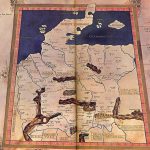Roman border defences on many of its frontiers in the Roman Empire were called limes. Some remains of Roman forts and fortifications have survived to this day. In Germany, since 2005, fragments of the Upper Germanic-Rhaetian limes have been inscribed on the UNESCO World Heritage List.
In December 2019, Germany and the Netherlands applied to UNESCO to include the border on the lower Rhine – the Low German Limes on this list. These are the remains of Roman fortifications along the Rhine from the vicinity of the city of Bonn in Germany to the mouth of the Rhine in today’s Netherlands, in antiquity separating the province of Germania Inferior from the barbarian Germanic tribes of the so-called Great Germania (Germania Magna) and temporarily controlled and dependent lands beyond the Rhine in today’s northern Netherlands (the tribe of Frisians). It should be remembered that in antiquity the Rhine flowed into the North Sea further to the north than in present times, hence the remains of the Lower Germanic limes today are partly no longer located in the cities lying on the river.
UNESCO’s decision on inclusion on the World Heritage List will be known in July 2021.
The history of Roman rule over the lower Rhine begins with the Gallic Wars of Julius Caesar, who after subjugating Gaul he based his borders on the Rhine in 50 BCE On the lower Rhine, in place of the destroyed and defeated tribe of Eburones, Caesar settled the Germanic Ubii and Tungrians. During the reign of Emperor Augustus in 16 BCE the combined Germanic tribes from across the Rhine: Sugambri, Tenkter and Usipeti defeated Marcus Lollius Paulinus, entering deep into Gallic territory. As a result of the defeat, the emperor himself went to Gaul, where in the years 16-13 BCE stabilized the situation, and founded the Roman military camps Ulpia Noviomagus Batavorum (today’s Nijmegen in the Netherlands) and Castra Vetera (today’s Xanten in Germany), later elements of the Lower Germanic limes. From the expedition of Augustus, the frontier until Varus’ defeat in the Teutoburg Forest in 9 CE the border on the lower Rhine was not a defensive border, it was often the starting point for the offensives of the Roman army to Germania Greater. However, all the gains on the right bank of the Rhine were lost with the defeat of Varus by Arminius.
During the reign of Tiberius there was a strengthening and consolidation of the border on the lower Rhine, although in 14 CE several Roman garrisons, including in Vetera and Novaesium (today’s Neuss in Germany) rebelled against the emperor – the rebellion was calmed by Germanicus. The lower Rhine frontier became a defensive frontier and was fairly peaceful, except for the uprisings of the Aedui and Treveri in 21 CE, then the Frisians in 28 CE. because of high taxation.
During the reign of Caligula, a limes municipium was established in Praetorium Agrippinae near the North Sea coast (present-day Valkenburg in the Netherlands). In the times of Claudius, many fortified legionary camps were established in the area of the limes in today’s Netherlands: Matilo (today’s Leiden), Albaniana (Alphen an der Rijn), Nigrum Pullum (Alphen-Zwammerdamm) or Traiectum (Utrecht). In 69 CE during the fights between Vitelius and Vespasian for the seizure of the imperial purple on the lower Rhine, the Batavian uprising, being under Roman rule, fielded auxiliary troops. The rebellious troops attacked Bonna (today’s Bonn) and surrounded the Roman legions at Castra Vetera. As late as 69 CE Marcus Flaccus defeated the rebellious troops and allied Chatti from across the Rhine, but his murder and taking over the command by Quintus Cerialis was used by the rebels and the auxiliary troops of other Celtic tribes under Roman rule, such as the Treveri, joining them. The insurgents did not meet the conditions for the Roman army to leave the surrounding Castra Vetera and murdered many soldiers. Such fortresses as the aforementioned Casta Vetera, Novaesium, Bonna and Praetorium Agrippinae were burnt down. In the course of follow-up in 70 CE, the insurgents suffered a series of defeats, and the few survivors managed to break through the Rhine.
After the uprising, the military organization was renewed and the fortifications and camps were rebuilt.
In 77-78 CE, the troops from the border on the lower Rhine carried out a successful campaign against the Brukter tribe, and during the uprising in 89 CE remained faithful to Domitian. The border remained quite calm, unlike other borders – on the Danube, in the upper course of the Rhine, or in the East of the Empire. The border on the lower Rhine was not attacked during the Marcomanian Wars, and the troops stationed there enjoyed the benevolence of the emperors. Due to the peace on the border, already under Flavians, the number of stationed legions was reduced from four to three, and under Trajan to two.
In the 3rd century CE, when the Upper Egerman-Rhaetian limes were heavily attacked by the Alamanni, the barbarian pressure on the border increased, but there was no such damage as in other sections. Only in 276 CE, there was a large Frankish invasion which caused great destruction. Invasions were repeated in the following years, and Emperor Constantius I, although repulsed the attacks, allowed a group of Salic Franks to settle in Roman territory. In 358 CE emperor Julian allowed the Franks to settle in the territory of the so-called Toxandria between the rivers Scheldt and Meuse in exchange for protection and peace on the borders. The Franks remained in these territories until the end of the Western Roman Empire, gradually expanding their territory further and further south, deep into Roman Gaul.







